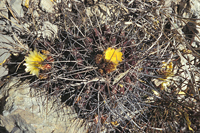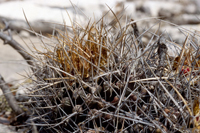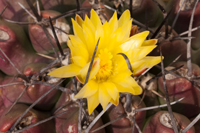Basionym: Thelocactus flavus Mosco & Zanovello, Cactus & Co., 3: 20 (1999).
Holotype: Huizache, San Luis Potosi, Mexico, Kuenzler 362, cult. A. Mosco, November 1998 (HG-PAD H0014963).
Synonyms: Thelocactus panarottoanus Halda, Acta Mus. Richnov. Sect. nat. 5: 161 (1998).
Description
Stem single or clustering and forming small clumps up to 40 cm across, globose, single heads 5-12 cm wide. Ribs indistinct. Tubercles conical. Areoles with glands. Central spines 4, 15-80 mm long, ochre to greyish, straight or slightly curved, acicular. Radial spines 3-5, 7-35 mm long, ochre to greyish, straight, acicular. Flowers 30-45 mm wide, yellow. Seeds 2.2 x 1.7 mm, testa cells conical with a smooth surface.
Distribution
Mexico, San Luis Potosí, restricted to a small area between Entronque Huizache and La Hincada, occurring in matorral xerofilo on limestone hills, at elevations of about 1200 to 1600 metres above sea level. Its range lies within the Meseta Central subregion of the Chihuahuan Desert ecoregion.
Risk assessment
Thelocactus conothelos ssp. flavus is placed in the category Pr (subject to special protection) of the Norma Oficial Mexicana NOM-059-SEMARNAT-2010.
Comments
This species has been well known for a long time and is sometimes listed in catalogues under the name Thelocactus longispinus n. n. which have also been distributed with the field number HK362. It has always been misidentified as Thelocactus tulensis and considered a yellow flowering form of it. At a glance, flavus resembles tulensis in the epidermis colour and the long central spines, but the relationship stops here. There are indeed many remarkable differences between the two species: in flavus the areoles bear one or two glands, missing in tulensis; the radial spines are quite different in number and arrangement; the flowers of flavus are yellow with the primary stamens inserted above the receptacle base, while the flowers of tulensis are white to pink with the primary stamens inserted at the base of the receptacle. The two species are noticeably different in seed micro-morphology. In flavus the seed cuticle is smooth and the testa cells are conical, while in tulensis the seed cuticle is granular and the testa cells are flat. For the flower morphology and seed micro-morphology, flavus is, instead, referable to the Thelocactus conothelos complex.
Panarottoanus is the same. It has priority over flavus at species rank, bur at subspecies rank flavus is the correct epithet to be used.
Thelocactus conothelos ssp. flavus (Mosco & Zanovello) Mosco & Zanovello, Bradleya 18: 63 (2000).
 The holotype of Thelocactus flavus Mosco & Zanovello
The holotype of Thelocactus flavus Mosco & Zanovello
Huizache, San Luis Potosi, Mexico, Kuenzler 362, cult. A. Mosco, November 1998 (HG-PAD H0014963).
Image courtesy Museo Botanico di Padova.
enlarge
 Thelocactus conothelos ssp. flavus
Thelocactus conothelos ssp. flavus
El Huizache, San Luis Potosí
Photo: E. Nodari
enlarge
 Thelocactus conothelos ssp. flavus
Thelocactus conothelos ssp. flavus
El Huizache, San Luis Potosí
Photo: A. Mosco
enlarge
 Thelocactus conothelos ssp. flavus
Thelocactus conothelos ssp. flavus
La Hincada, San Luis Potosí
Photo: A. Mosco
enlarge
 Thelocactus conothelos ssp. flavus
Thelocactus conothelos ssp. flavus
Photo: A. Mosco
enlarge